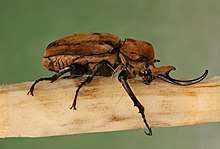Megasoma
Megasoma is a rhinoceros beetle genus. Commonly known as the elephant beetles, Megasoma species are found from the southern half of North America to most of South America.
| Megasoma | |
|---|---|
 | |
| Megasoma elephas, the elephant beetle | |
| Scientific classification | |
| Kingdom: | Animalia |
| Phylum: | Arthropoda |
| Class: | Insecta |
| Order: | Coleoptera |
| Family: | Scarabaeidae |
| Tribe: | Dynastini |
| Genus: | Megasoma Kirby, 1825 |
| Type species | |
| Megasoma actaeon (Linnaeus, 1758) | |
| Synonyms | |
|
Megalosoma Burmeister, 1847
| |
Appearance
Megasoma are generally large in size (as indicated by the name, which is "large body" in Greek). As a group, the genus contains some of the largest beetle species known. However, there are small species of this genus as well. The largest can be up to 135 mm, while small ones like Megasoma punctulatum can be around 20 mm.
Many Megasoma species (Megasoma elephas, Megasoma thersites, Megasoma gyas, Megasoma cedrosa, Megasoma anubis, Megasoma occidentale, Megasoma joergenseni, Megasoma vogti) have thin microscopic hairs (setae) covering nearly their entire bodies, giving the appearance of being pale or orange.
Males of most species have large horns that they use to wrestle with other males. Females do not have horns.
Diet
Larvae feed on tree or shrub roots. Adults usually drink tree sap or suck juice from fruit.
Behavior and Habitat
Adult Megasoma are nocturnal and are attracted to lights, and are often seen resting in trees.
Species list[1]
- Megasoma actaeon Linnaeus, 1758
- Megasoma anubis Chevrolat, 1836
- Megasoma cedrosa Hardy, 1972
- Megasoma elephas Fabricius, 1775
- Megasoma fujitai Nagai 2003
- Megasoma gyas Herbst, 1785
- Megasoma hermes Prandi, 2016
- Megasoma janus Felsche, 2006
- Megasoma joergenseni Bruch, 1910
- Megasoma lecontei Hardy, 1972
- Megasoma mars Reiche, 1852
- Megasoma nogueirai Morón, 2005
- Megasoma occidentale Bolivar, Pieltain, Jimenez-asua & Martinez, 1963
- Megasoma pachecoi Cartwright, 1963
- Megasoma punctulatum Cartwright, 1952
- Megasoma ramirezorum Silvestre et Arnaud, 2002
- Megasoma rex Prandi, 2018
- Megasoma sleeperi Hardy, 1972
- Megasoma svobodaorum Krajcik, 2009
- Megasoma thersites LeConte, 1861
- Megasoma vazdemelloi Prandi, 2018
- Megasoma vogti Cartwright, 1963
See also
References
- 2019 winter Bekuwa No.70
- Kirby, W. 1825. A description of such genera and species of insects, as alluded to in the "Introduction to Entomology" of Messrs. Kirby and Spence, as appear not to have been before sufficiently noticed or described. Transactions of the Linnean Society of London, 14: 563–572. Internet Archive [original description: p. 566]
- Schoolmeesters P. 2017. Scarabs: World Scarabaeidae Database (version Jul 2016). In: Roskov Y., Abucay L., Orrell T., Nicolson D., Bailly N., Kirk P., Bourgoin T., DeWalt R.E., Decock W., De Wever A., Nieukerken E. van, Zarucchi J., Penev L., eds. 2017. Species 2000 & ITIS Catalogue of Life, 30 January 2017. Digital resource at www.catalogueoflife.org/col. Species 2000: Naturalis, Leiden, the Netherlands. ISSN 2405-8858. Reference page.
- 2019 winter Bekuwa No.70 Megasoma group
| Wikispecies has information related to Megasoma |
| Wikimedia Commons has media related to Megasoma. |